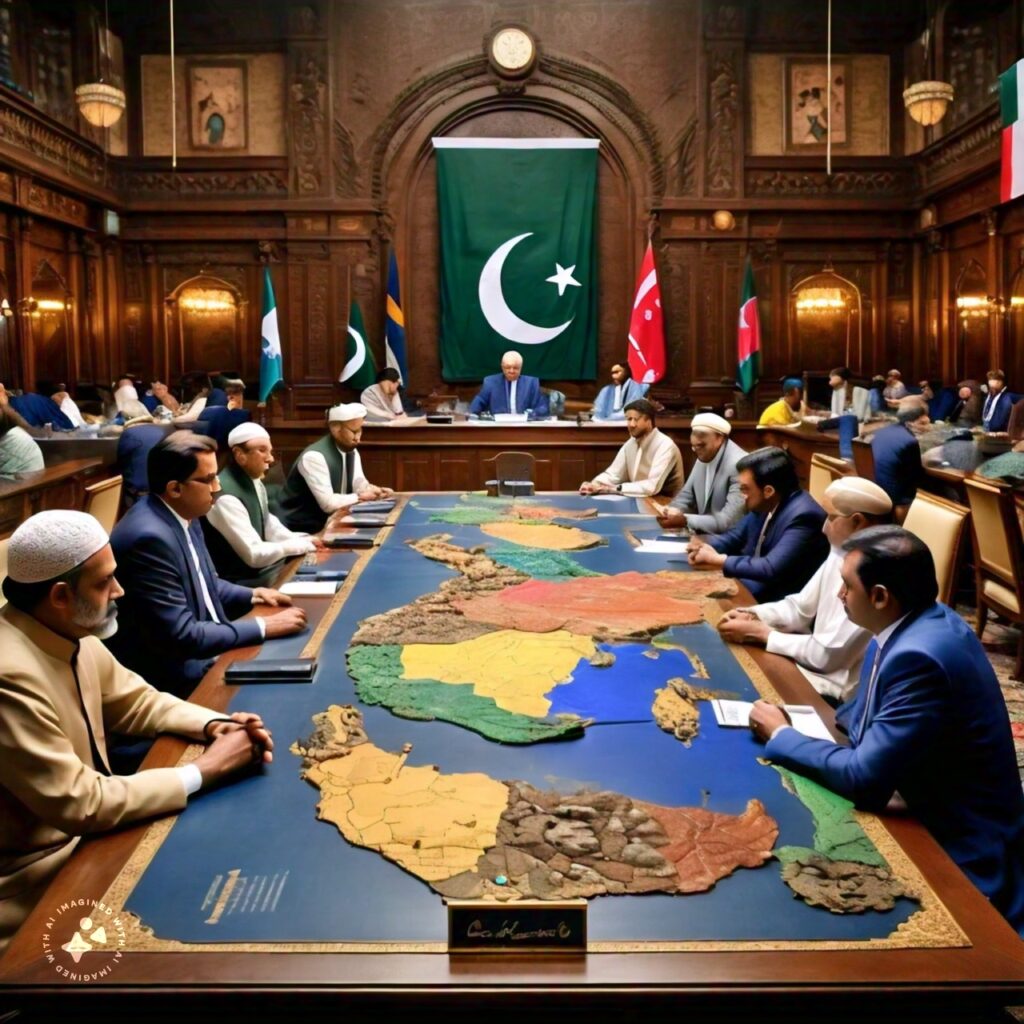Pakistan, located at the crossroads of South Asia, the Middle East, and Central Asia, has a strategic position in the global trade landscape. With a growing population of over 230 million people, Pakistan has the potential to become a significant player in international trade. However, in spite of its advantages, Pakistan’s trade relations have been beset by numerous challenges in recent years. In this blog, we will explore Pakistan’s position in trade relations, its current trade scenario, and the opportunities and challenges it faces.
Pakistan’s Current Trade Scenario
Pakistan’s trade scenario is characterized by a large trade deficit, which has been widening over the years. In 2020-21, Pakistan’s trade deficit reached an all-time high of $23.1 billion, with imports standing at $53.7 billion and exports at $30.6 billion. Pakistan relies heavily on remittances from overseas Pakistanis and foreign loans to finance its trade deficit, as exports have remained stagnant.
Pakistan’s trade is heavily reliant on a few sectors, including textiles, which account for more than 60% of the country’s total exports. Other significant export sectors include food, beverages, and tobacco, and petroleum products. Machinery, electrical equipment, and petroleum products make up the bulk of Pakistan’s imports.
Regional Trade Relations
Pakistan’s trade relations with its regional partners are critical to its economic growth and development. The country is a member of the South Asian Association for Regional Cooperation (SAARC) and the Economic Cooperation Organization (ECO), which provide a platform for regional trade and economic cooperation.
Pakistan-Afghanistan Trade Relations
Pakistan and Afghanistan have a long history of trade relations, with Pakistan being Afghanistan’s largest trading partner. The two countries have signed several trade agreements, including the Pakistan-Afghanistan Free Trade Agreement (PAFTA) in 2010, which aimed to increase bilateral trade and economic cooperation. However, trade between the two countries has been affected by security concerns and political tensions.

Pakistan-China Trade Relations
Pakistan and China have a strong trade relationship, with China being Pakistan’s largest trading partner. The two countries have signed several trade agreements, including the China-Pakistan Free Trade Agreement (CPFTA) in 2006, which aimed to increase bilateral trade and economic cooperation. Furthermore, in addition to its significant trade investments, China has also invested heavily in Pakistan’s infrastructure and energy sectors, particularly through the China-Pakistan Economic Corridor (CPEC), a cornerstone of the Belt and Road Initiative (BRI).
Pakistan-India Trade Relations
Pakistan and India’s political tensions and security concerns restrict and complicate their trade relations. The two countries have signed several trade agreements, including the Pakistan-India Trade Agreement in 2011, which aimed to increase bilateral trade and economic cooperation. However, trade between the two countries has been limited due to restrictions on trade in certain sectors and products.

Global Trade Relations
Pakistan’s trade relations with the global community are also critical to its economic growth and development. The country is a member of the World Trade Organization (WTO) and has signed several trade agreements with countries around the world.
Pakistan-European Union Trade Relations
Pakistan and the European Union (EU) have a significant trade relationship, with the EU being Pakistan’s largest export market. The two sides have signed several trade agreements, including the Pakistan-EU Trade Agreement in 2013, which aimed to increase bilateral trade and economic cooperation. Additionally, Pakistan has also been granted the Generalized System of Preferences (GSP) plus status by the EU, which provides duty-free and quota-free access to the EU market for Pakistani products, thereby further boosting its export potential.
Pakistan-United States Trade Relations
Pakistan and the United States have a significant trade relationship, with the US being Pakistan’s largest trading partner. The two countries have signed several trade agreements, including the Pakistan-US Trade and Investment Framework Agreement (TIFA) in 2003, which aimed to increase bilateral trade and economic cooperation. Pakistan has also been granted the GSP status by the US, which provides duty-free and quota-free access to the US market for Pakistani products.
Opportunities and Challenges
Pakistan’s trade relations face several opportunities and challenges. Some of the key opportunities include:
- Regional trade integration: Pakistan has the opportunity to increase its trade with its regional partners, including Afghanistan, China, and India, through regional trade agreements and economic cooperation.
- Global value chains: Pakistan has the opportunity to integrate into global value chains, particularly in the textile and manufacturing sectors, to increase its exports and economic growth.
- Investment in infrastructure: Pakistan has the opportunity to attract investment in its infrastructure sector, including energy, transportation, and logistics, to increase its trade and economic growth.

Some of the key challenges include:
- Political instability: Political instability and security concerns have affected Pakistan’s trade relations with its regional and global partners.
- Trade deficit: Pakistan’s large trade deficit has put pressure on its foreign exchange reserves, consequently limiting its ability to invest in key sectors such as education, healthcare, and infrastructure. Moreover, the imbalance in trade exacerbates economic vulnerabilities, further straining government resources. As a result, the country’s development initiatives face significant setbacks, hindering progress and growth. Ultimately, addressing the trade deficit is crucial for improving the overall economic stability and development potential of Pakistan.
- Low exports: Pakistan’s exports have been stagnant, and the country has failed to diversify its export base, making it vulnerable to external shocks.
- High tariffs: Pakistan’s high tariffs have made its exports uncompetitive in the global market, and the country has failed to reduce tariffs on key imports, making it difficult to attract foreign investment.
- Corruption: Corruption and bureaucratic red tape have affected Pakistan’s trade relations, making it difficult for businesses to operate and invest in the country.
- Infrastructure: Pakistan’s infrastructure, including its transportation and logistics networks, is underdeveloped, making it difficult to trade with its regional and global partners.
Way Forward
To address these challenges and opportunities, Pakistan needs to adopt a comprehensive trade policy that focuses on:
- Diversifying exports: Pakistan needs to diversify its export base, particularly in the manufacturing and services sectors, to reduce its dependence on textiles and, consequently, increase its exports. By broadening the range of products and services it offers, the country can mitigate risks associated with reliance on a single sector. Additionally, diversifying exports can enhance economic resilience, leading to more sustainable growth. Therefore, strategic investments in various industries are essential for achieving long-term economic stability and boosting export performance.
- Reducing tariffs: Pakistan needs to reduce its tariffs on key imports, particularly in the manufacturing and agriculture sectors, to make its exports more competitive and, consequently, attract foreign investment. By lowering these tariffs, the country can decrease production costs, thereby enhancing the global competitiveness of its products. Furthermore, reduced tariffs can encourage technological advancements and innovation within these sectors. Ultimately, these measures will not only stimulate economic growth but also improve Pakistan’s position in the international market.
- Investing in infrastructure: Pakistan needs to invest in its infrastructure, including its transportation and logistics networks, to increase its trade and economic growth.
- Promoting regional trade: Pakistan needs to promote regional trade, particularly with its neighbors, Afghanistan, China, and India, to increase its trade and, consequently, spur economic growth. By fostering stronger economic ties with these neighboring countries, Pakistan can tap into new markets and enhance its export potential. Moreover, regional trade collaboration can lead to shared infrastructure projects and reduced logistical costs. Ultimately, these efforts will contribute to a more robust and interconnected regional economy, benefiting Pakistan’s overall development.
- Addressing corruption: Pakistan needs to address corruption and bureaucratic red tape to make it easier for businesses to operate and invest in the country.
Conclusion
Pakistan’s trade relations are critical to its economic growth and development. The country has the potential to become a significant player in international trade, but it faces several challenges, including a large trade deficit, low exports, high tariffs, corruption, and underdeveloped infrastructure. To address these challenges, Pakistan needs to adopt a comprehensive trade policy that focuses on diversifying exports, reducing tariffs, investing in infrastructure, promoting regional trade, and addressing corruption. By adopting such a policy, Pakistan can increase its trade and economic growth, and become a more significant player in international trade.



One comment
anm"ala dig till binance
February 28, 2025 at 7:19 am
Your article helped me a lot, is there any more related content? Thanks!